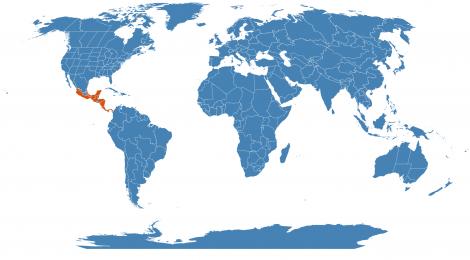Accession Data:
Monstera deliciosa Liebm.
- Common Name: Swiss Cheese Plant
- Family: Araceae Juss.
- Description: A jungle climbing relative of the philodendron from Mexico and Guatemala. It is seen in gardens in tropical and subtropical areas, growing well in partial sun or shade. The plant begins bearing after three years. Popular as a houseplant, it seldom fruits in the home. The large petiole or axis; also applied to how the lateral veins are arranged in relation to the main vein.">pinnate leaves are perforated with oblong or oval holes, hence one common name. The 9", dull, deep green, cone-like fruit is actually an unripened flower spike, covered with hexagonal scales that dry out and separate as the fruit ripens from the base upwards, revealing the white pulp. It takes a little longer than a year to mature to an edible stage. Unripe fruit, if eaten causes irritation to the mouth and throat because of the oxalic acid. It can be induced to ripen by picking when the base has started to wrinkle and wrapping in a bag for a few days. When unwrapped, the scales should have separated.
Another interesting characteristic of this plant is that the seedlings, upon germination, will grow in the direction of the darkest area (not just merely away from light) until they encounter the base of a tree to grow on. They will then begin to climb toward the light which is generally up into the canopy of the tree upon which it is growing.
Propagated by cuttings of mature wood or air layering.
- Uses: Unripe fruit can cause swelling of mucous membranes...
- USDA Zone: 10a-11
Accession Data:
- Accession # 198500876
- Source: Unknown
- Accession Date: 12-31-1985
- Bench: 4112 - EPI: North Wall
- Currently: active - healthy
- Qty: 1 confirmed on 07-01-2025
- Restrictions:
- Poisonous Plant Parts - Not for Human Consumption
- Poisonous Plant Parts - Not for Human Consumption
Classification:
- Division: Magnoliophyta
- Class: Liliopsida
- SubClass: monocots
- Order: Alismatales
- SubOrder:
- Family: Araceae
- SubFamily: Monsteroideae
- Tribe: Monstereae
- SubTribe:
Flowering Data:
This accession has been observed in bloom on:| Year | Jan | Feb | Mar | Apr | May | Jun | Jul | Aug | Sep | Oct | Nov | Dec | ||||||||||||||||||||||||||||||||||||||||
|---|---|---|---|---|---|---|---|---|---|---|---|---|---|---|---|---|---|---|---|---|---|---|---|---|---|---|---|---|---|---|---|---|---|---|---|---|---|---|---|---|---|---|---|---|---|---|---|---|---|---|---|---|
| 2025 | ||||||||||||||||||||||||||||||||||||||||||||||||||||
| 2024 | ||||||||||||||||||||||||||||||||||||||||||||||||||||
References (internal):
- Fenestrate
- EEB 3271 - Systematic Botany
- EEB 3203 - Developmental Plant Morphology
- Floriculture CDE Plant List
- Scavenger Hunt - Grades 9-12 (generic)
- EEB Greenhouse Holdings native to: Mexico Gulf / Mexico Southwest / Mexico Southeast / Costa Rica / Guatemala / Honduras / Nicaragua / Panama
References (external):
- California Rare Fruit Growers WWW Site
- The Plant List (2013). Version 1.1. Last accessed on Tuesday, March 01, 2016.
- WCSP (2016). World Checklist of Selected Plant Families. Facilitated by the Royal Botanic Gardens, Kew. Last accessed on Tuesday, March 01, 2016.
- R. Strong Jr, Donald & S. Ray Jr, Thomas. (1975). Host Tree Location Behavior of a Tropical Vine (Monstera gigantea) by Skototropism. Science. 190. 804-806. 10.1126/science.190.4216.804. Last accessed on Thursday, May 24, 2018.
data regenerated on Wed, 02 Jul 2025 09:55:09 -0400 [bcm v4.0]
Images:

Additional images for this accession:
Click on thumbnails to enlargeCurrent Accessions in the Araceae
Subfamily Aroideae
Subfamily Aroideae
Tribe Anubiadeae
Subfamily Aroideae
Tribe Areae
Subfamily Aroideae
Tribe Arisaemateae
Subfamily Aroideae
Tribe Caladieae
Subfamily Aroideae
Tribe Colocasieae
- Alocasia Amazonica


- Alocasia cuprea

- Alocasia melo

- Alocasia Micholitziana



- Colocasia affinis



- Colocasia esculenta

- Colocasia fallax

- Colocasia gigantea cv. Thailand Giant

- Remusatia vivipara

Subfamily Aroideae
Tribe Culcasieae
Subfamily Aroideae
Tribe Dieffenbachieae
Subfamily Aroideae
Tribe Philodendreae
- Philodendron angustisectum

- Philodendron atabapoense

- Philodendron bipinnatifidum

- Philodendron brandtianum

- Philodendron crassinervium

- Philodendron gloriosum

- Philodendron grazielae

- Philodendron hederaceum var. oxycardium

- Philodendron imbe


- Philodendron joepii
- Philodendron ornatum

- Philodendron panduriforme

- Philodendron patriciae W/C

- Philodendron pedatum

- Philodendron tripartitum


- Philodendron verrucosum

Subfamily Aroideae
Tribe Pisteae
Subfamily Aroideae
Tribe Spathicarpeae
Subfamily Aroideae
Tribe Thomsonieae
- Amorphophallus albus

- Amorphophallus bulbifer


- Amorphophallus dunnii


- Amorphophallus henryi

- Amorphophallus impressus

- Amorphophallus konjac


- Amorphophallus muelleri

- Amorphophallus paeoniifolius

- Amorphophallus pygmaeus W/C


- Amorphophallus titanum


- Amorphophallus titanum


- Amorphophallus titanum


- Amorphophallus titanum


- Amorphophallus variabilis


- Amorphophallus yunnanensis


- Amorphophallus yunnanensis


Subfamily Aroideae
Tribe Zantedeschieae
Subfamily Lasioideae
Subfamily Lemnoideae
Subfamily Monsteroideae
Tribe Monstereae
- Epipremnum falcifolia

- Epipremnum pinnatum
- Monstera adansonii

- Monstera deliciosa



- Monstera dubia

- Monstera siltepecana

- Monstera subpinnata
- Rhaphidophora cryptantha

- Rhaphidophora decursiva
- Rhaphidophora korthalsii

- Rhaphidophora sulcata

- Scindapsus pictus

- Scindapsus pictus 'Exotica'

- Stenospermation sp.
Subfamily Monsteroideae
Tribe Spathiphylleae
Subfamily Pothoideae
Tribe Anthurieae
- Anthurium andraeanum



- Anthurium bakeri



- Anthurium crystallinum

- Anthurium cubense

- Anthurium forgetii

- Anthurium forgetii

- Anthurium forgetii

- Anthurium friedrichsthalii


- Anthurium gracile


- Anthurium luxurians

- Anthurium pedatoradiatum

- Anthurium pendens


- Anthurium pentaphyllum var. bombacifolium

- Anthurium podophyllum W/C



- Anthurium pseudospectabile W/C


- Anthurium scandens


- Anthurium schlechtendalii


- Anthurium veitchii

- Anthurium villenaorum
- Anthurium wendlingeri



Subfamily Pothoideae
Tribe Potheae
Subfamily Zamioculcadoideae
W/C = Wild Collected = indicates flowering in past 14 days
= indicates flowering in past 14 days
 = images available for this accession
= images available for this accession
 = map available for this accession
= map available for this accession
 = accession added within past 90 days
= accession added within past 90 days



